Разделы презентаций
- Разное
- Английский язык
- Астрономия
- Алгебра
- Биология
- География
- Геометрия
- Детские презентации
- Информатика
- История
- Литература
- Математика
- Медицина
- Менеджмент
- Музыка
- МХК
- Немецкий язык
- ОБЖ
- Обществознание
- Окружающий мир
- Педагогика
- Русский язык
- Технология
- Физика
- Философия
- Химия
- Шаблоны, картинки для презентаций
- Экология
- Экономика
- Юриспруденция
Тема 4. Смысл и контекст
Содержание
- 1. Тема 4. Смысл и контекст
- 2. Тема 4. Смысл и контекст СМЫСЛ— внутреннее
- 3. Э.Т.Холл о роли контекста в коммуникативных процессах
- 4. Edward Twitchell Hall КнигиThe Silent Language. New
- 5. Э.Т.Холл о роли контекста в коммуникативных процессахThroughout
- 6. Э.Т.Холл о роли контекста в коммуникативных процессахProxemics
- 7. Э.Т.Холл о роли контекста в коммуникативных процессахStrangers
- 8. Э.Т.Холл о роли контекста в коммуникативных процессахThe
- 9. Э.Т.Холл о роли контекста в коммуникативных процессахIn
- 10. Э.Т.Холл о роли контекста в коммуникативных процессахBody
- 11. Э.Т.Холл о роли контекста в коммуникативных процессахHall
- 12. Hall's cultural factors High contextIn a high-context
- 13. Hall's cultural factors Low contextIn a low-context
- 14. Hall's cultural factors Contrasting the twoFrench contracts
- 15. Слайд 15
- 16. Слайд 16
- 17. Э.Т.Холл о роли контекста в коммуникативных процессах
- 18. Э.Т.Холл о роли контекста в коммуникативных процессах
- 19. Типы культур с точки зрения коммуникативных процессовTimeMonochronic
- 20. Типы культур с точки зрения коммуникативных процессовPolychronic
- 21. Типы культур с точки зрения коммуникативных процессовWestern
- 22. Слайд 22
- 23. Типы культур с точки зрения коммуникативных процессов.
- 24. 4.3. Культуры с высокой / низкой
- 25. 4.3. Культуры с высокой / низкой степенью ориентации на контекстДистанция между русскими и английскими коммуникантами
- 26. 4.3. Культуры с высокой / низкой степенью
- 27. 4.3. Культуры с высокой / низкой степенью ориентации на контекст
- 28. Слайд 28
- 29. Английский стиль невербальной коммуникации• значительная пространственная дистанция;
- 30. Русский стиль коммуникации• достаточно близкая дистанция общения;
- 31. Коммуникативные правила• Соблюдайте дистанцию: не приближайтесь близко
- 32. Скачать презентанцию
Слайды и текст этой презентации
Слайд 1Тема 4. Смысл и контекст
Э.Т.Холл о роли контекста в
коммуникативных процессах
/ низкой степенью ориентации на контекстСлайд 2Тема 4. Смысл и контекст
СМЫСЛ— внутреннее содержание, значение ч.-л.,
то, что может быть понято.Каждое выражение несет в себе мысленное
содер ание, которое и называют С. Понять некоторое выражение — значит усвоить его С. Если С. усвоен, то мы знаем, к каким объектам относится данное выражение, следовательно, С. выражения задает его предметное значение. Два выражения могут иметь одно и то же предметное значение, но различаться по С. Смысл сущность любого феномена, которая не совпадает с ним самим и связывает его с более широким контекстом реальности.контекст
1) речевое окружение, композиционно-речевая система, предполагающая единство плана содержания и плана выражения.
2) бытовой контекст - ситуация, которая определяет, в каком значении употреблено слово (операция: хирургическая операция, боевая операция, финансовая операция);
3) Лексический контекст – словесное окружение, лексическая позиция слова. Контекст выявляет то или иное значение многозначного слова;
Слайд 4Edward Twitchell Hall
Книги
The Silent Language. New York: Doubleday, 1959
The Hidden Dimension. New York: Doubleday,1966
Beyond Culture. New York:
Doubleday, 1976 The Dance of Life, The Other Dimension of Time. New York: Doubleday, 1983
Hidden Differences: Studies in International Communication. Hamburg: Grunder & Jahr, 1983, 1984, 1985
Hidden Differences: Doing Business with the Japanese. Garden City, NY, Anchor Press/ Doubleday, 1987
Understanding Cultural Differences, Germans, French and Americans. Yarmouth: Intercultural Press, 1990
Слайд 5Э.Т.Холл о роли контекста в коммуникативных процессах
Throughout his career, Hall
introduced a number of new concepts, including proxemics, polychronic and
monochronic time, and high and low context culture. In his second book, The Hidden Dimension, he describes the culturally specific temporal and spatial dimensions that surround each of us, such as the physical distances people maintain in different contexts.Слайд 6Э.Т.Холл о роли контекста в коммуникативных процессах
Proxemics is a psychological,
social-psychological, and anthropological area of study that addresses the use
of space in interpersonal communication, usually in regards to the distance between people in conversation . The term was first coined by cultural anthropologist Edward T. Hall in 1963[1] . Hall notes that the value in studying Proxemics comes from its applicability in evaluating not only the way man interacts with others in his daily life, but also "the organization of space in his houses and buildings, and ultimately the layout of his towns[2] .[1] Hall, Edward T. (1966). The Hidden Dimension.
[2] Hall, Edward T. (October 1963). "A System for the Notation of Proxemic Behavior". American Anthropologist 65 (5): 1003-1026
Слайд 7Э.Т.Холл о роли контекста в коммуникативных процессах
Strangers waiting for a
train in Oklahoma try to maintain at least 18" of
personal space. Edward Hall's theory of proxemics suggests that people will maintain differing degrees of personal distance depending on the social setting and their cultural backgrounds.Слайд 8Э.Т.Холл о роли контекста в коммуникативных процессах
The design of houses
and neighborhoods is also governed by culturally specific spatial principles
and aesthetic standards. An aerial view of Yorkship Village in Camden NJ, a planned community constructed by the U.S. government in 1918, shows the winding residential streets and central community park that epitomized ideal suburban life near the turn-of-the-century.Ideal Suburban Life Near the Turn-of-the-Century
Слайд 9Э.Т.Холл о роли контекста в коммуникативных процессах
In animals, Swiss zoologist
Heini Hediger had distinguished between flight distance (run boundary), critical
distance (attack boundary), personal distance (distance separating members of non-contact species, as a pair of swans), and social distance (intraspecies communication distance). Hall reasoned that, with very few exceptions, flight distance and critical distance have been eliminated in human reactions, and thus interviewed hundreds of people to determine modified criteria for human interactions.Слайд 10Э.Т.Холл о роли контекста в коммуникативных процессах
Body spacing and posture,
according to Hall, are unintentional reactions to sensory fluctuations or
shifts, such as subtle changes in the sound and pitch of a person's voice. Social distance between people is reliably correlated with physical distance, as are intimate and personal distance, according to the following delineations:Intimate distance for embracing, touching or whispering
Close phase – less than 6 inches (15 cm)
Far phase – 6 to 18 inches (15 to 46 cm)
Personal distance for interactions among good friends or family members
Close phase – 1.5 to 2.5 feet (46 to 76 cm)
Far phase – 2.5 to 4 feet (76 to 120 cm)
Social distance for interactions among acquaintances
Close phase – 4 to 7 feet (1.2 to 2.1 m)
Far phase – 7 to 12 feet (2.1 to 3.7 m)
Public distance used for public speaking
Close phase – 12 to 25 feet (3.7 to 7.6 m)
Far phase – 25 feet (7.6 m) or more.
Слайд 11Э.Т.Холл о роли контекста в коммуникативных процессах
Hall notes that different
cultures maintain different standards of personal space. In Latin cultures,
for instance, those relative distances are smaller, and people tend to be more comfortable standing close to each other; in Nordic cultures the opposite is true. Realizing and recognizing these cultural differences improves cross-cultural understanding, and helps eliminate discomfort people may feel if the interpersonal distance is too large ("stand-offish") or too small (intrusive). Comfortable personal distances also depend on the culture, social situation, gender, and individual preference.Слайд 12Hall's cultural factors
High context
In a high-context culture, there are
many contextual elements that help people to understand the rules.
As a result, much is taken for granted.This can be very confusing for person who does not understand the 'unwritten rules' of the culture.
Слайд 13Hall's cultural factors
Low context
In a low-context culture, very little
is taken for granted. Whilst this means that more explanation
is needed, it also means there is less chance of misunderstanding particularly when visitors are present.Слайд 14Hall's cultural factors
Contrasting the two
French contracts tend to be
short (in physical
length, not time duration) as much of the
information
is available within the high-contextFrench culture. American content, on the other
hand, is low-context and so contracts tend to be
longer in order to explain the detail.
Highly mobile environments where people come and go need lower-context culture. With a stable population, however, a higher context culture may develop.
Слайд 19Типы культур с точки зрения коммуникативных процессов
Time
Monochronic time
M-Time, as he
called it, means doing one thing at a time. It
assumes careful planning and scheduling and is a familiar Western approach that appears in disciplines such as 'time management'.Monochronic people tend also to be low context.
Слайд 20Типы культур с точки зрения коммуникативных процессов
Polychronic time
In Polychronic cultures,
human interaction is valued over time and material things, leading
to a lesser concern for 'getting things done' -- they do get done, but more in their own time.Aboriginal and Native Americans have typical polychronic cultures, where 'talking stick' meetings can go on for as long as somebody has something to say.
Polychronic people tend also to be high context.
Слайд 21Типы культур с точки зрения коммуникативных процессов
Western cultures vary in
their focus on monochronic or polychronic time. Americans are strongly
monochronic whilst the French have a much greater polychronic tendency -- thus a French person may turn up to a meeting late and think nothing of it (much to the annoyance of a German or American co-worker).Слайд 23Типы культур с точки зрения коммуникативных процессов. So what?
When working
across cultures, pay attention
to high and low cultures through the
actionsof others. For example if people are late for
meetings it may be because they are
polychronic, not because they are
disrespectful or lazy.
When you understand the personal, national
or organizational culture, then you can seek
to align with them and hence gain greater influence.
Слайд 24 4.3. Культуры с высокой / низкой степенью ориентации на контекст
Higher Context Cultures:USA - southern states, China, Arab countries, Italy,
Greece, Japan, Spain, Korea, India, Brazil, Russia Lower Context Cultures:[USA - northern states, Canada, German-speaking countries, Scandinavia, Poland
Spectrum: Low context culture < Scandinavian < German-Swiss < German < North American < French < English < Italian < Spanish < Mexican < Greek < Arab < Korean < Japanese < Chinese < High context culture
Слайд 254.3. Культуры с высокой / низкой степенью ориентации на контекст
Дистанция
между русскими и английскими коммуникантами
Слайд 264.3. Культуры с высокой / низкой степенью ориентации на контекст
privacy
[‘praıvəsı, ‘prıvəsı] 1) a state in which one is not
observed or disturbed by other people 2) the state of being free from public attention.If you have privacy, you are in a place or situation which allows you to do things without other people seeing you or disturbing you. If someone or something invades your privacy, they interfere in your life without your permission.
Слайд 29Английский стиль невербальной коммуникации
• значительная пространственная дистанция;
• бережное отношение
к незыблемости личного пространства каждого из участников коммуникативного акта, его
автономии, недопустимость его нарушения;• практически полное отсутствие тактильной коммуникации;
• ограниченное и сдержанное использование мимики и жестов;
• сдержанность в проявлении эмоций;
• социальная улыбчивость.
Слайд 30Русский стиль коммуникации
• достаточно близкая дистанция общения;
• незначительное личное
пространство и допустимость его нарушения;
• использование тактильной коммуникации;
•
более активная жестикуляция; • более интенсивная и выразительная мимика;
• открытое проявление эмоций;
• бытовая неулыбчивость.
В результате можно говорить о таких доминантных чертах невербальной коммуникации, как дистантность и сдержанность у англичан и контактность и бóльшая свобода действий у русских.
Слайд 31Коммуникативные правила
• Соблюдайте дистанцию: не приближайтесь близко к собеседнику.
•
Будьте внимательны не только к тем, кто находится в непосредственной
близости, но и дальше, т. е., расширяйте радиус, при котором следует обращать внимание на окружающих.• Будьте сдержанны в поведении.
• Ограничивайте жестикуляцию.
• Избегайте тактильных контактов.
• Не протягивайте руку для пожатия при каждой встрече.
• Контролируйте эмоции.
• Не перебивайте собеседника.
• Соблюдайте поочередность реплик.
• Демонстрируйте хорошее настроение – улыбайтесь!




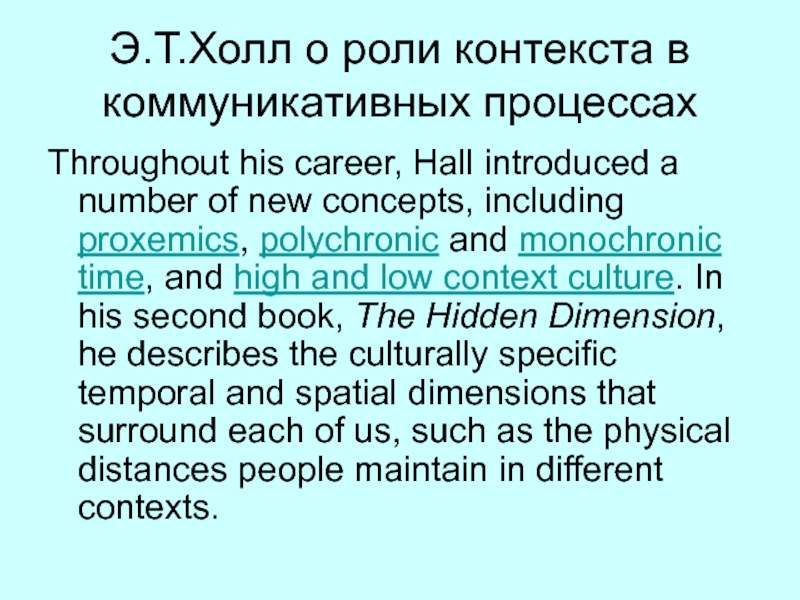
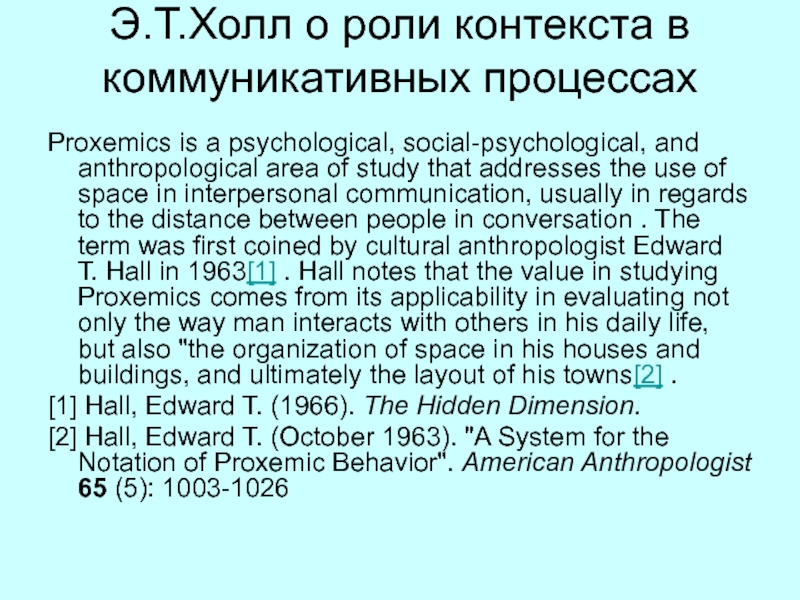
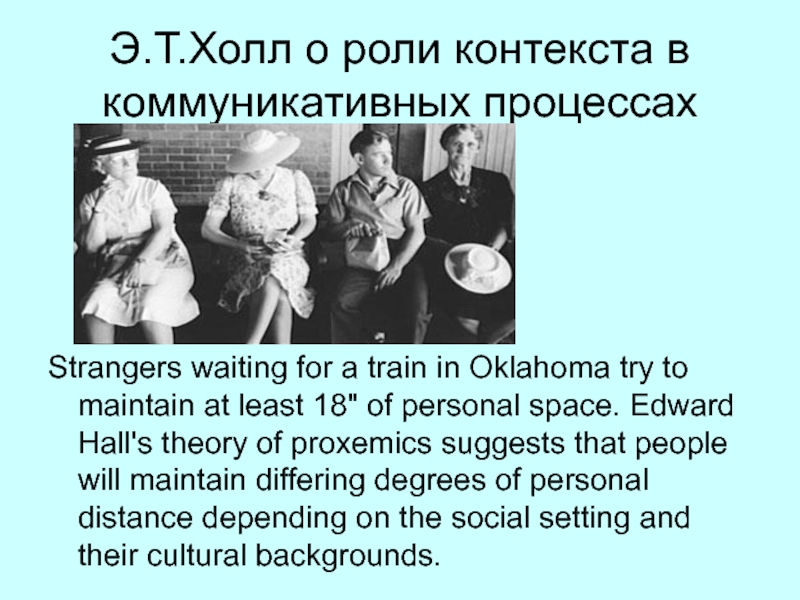
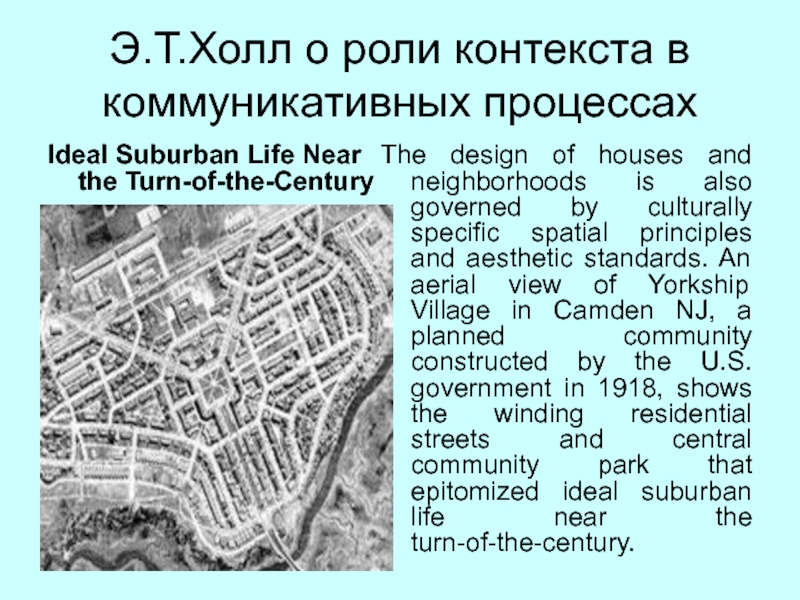
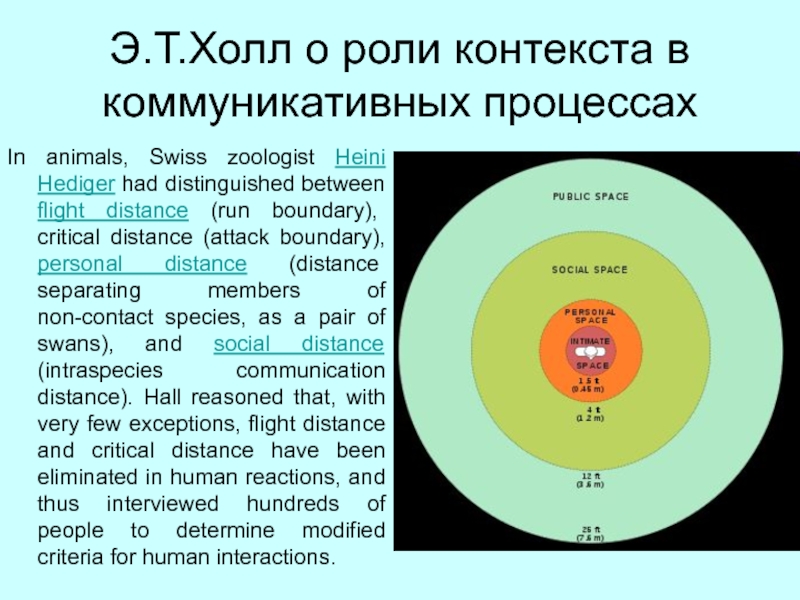
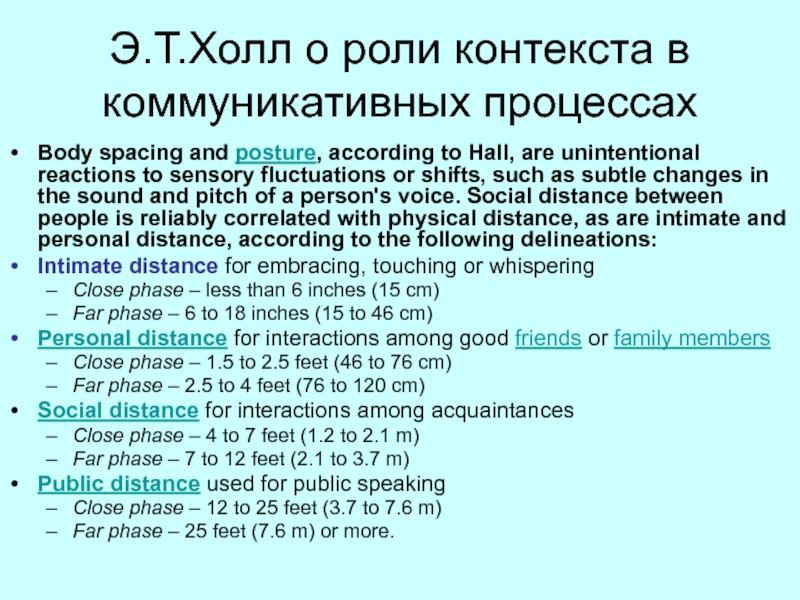
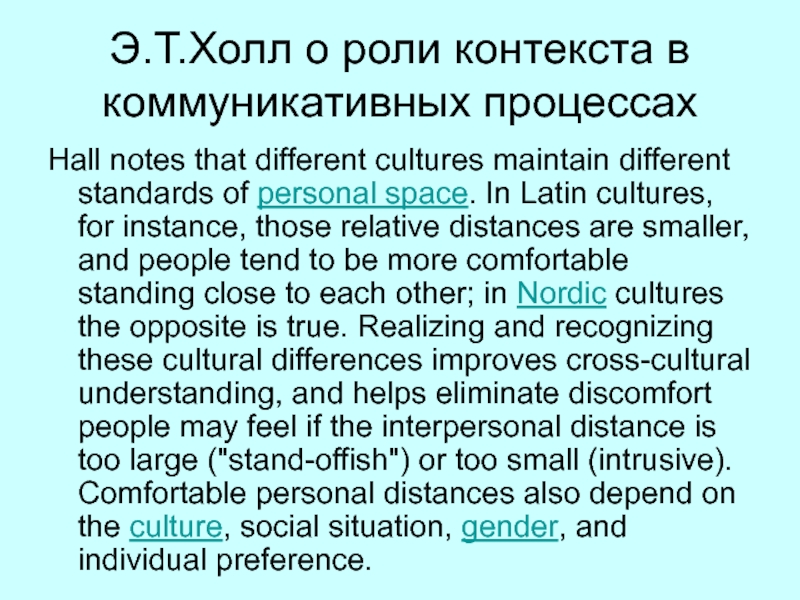
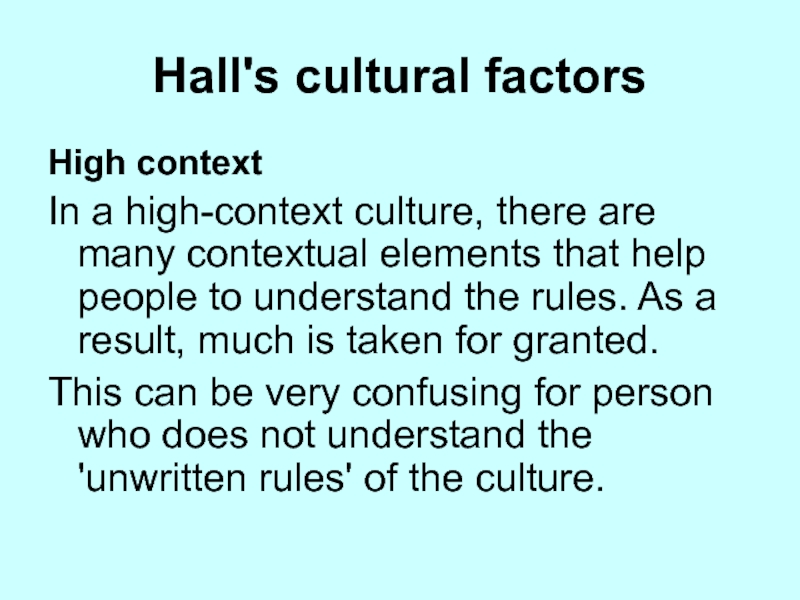
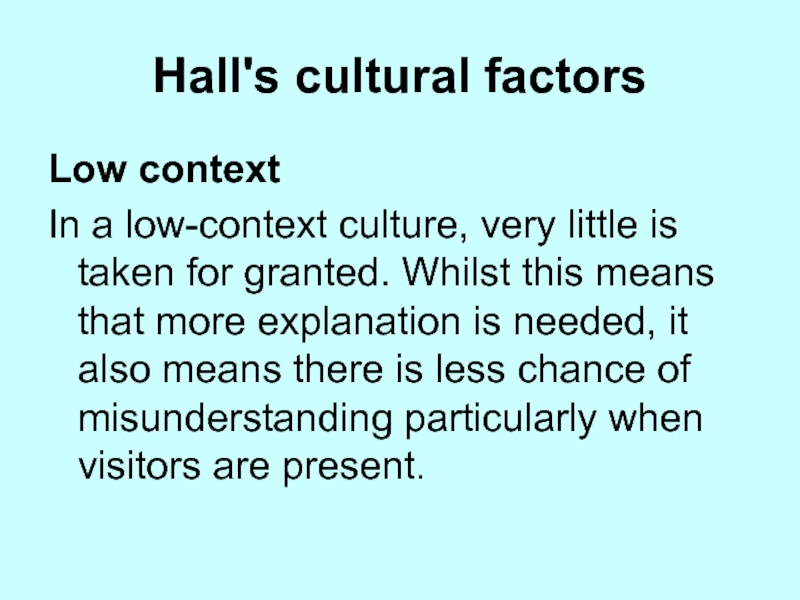
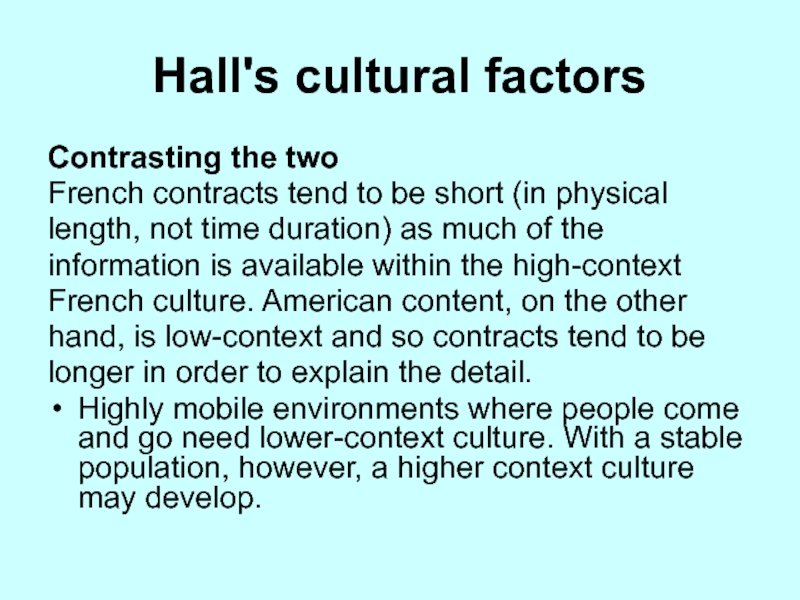
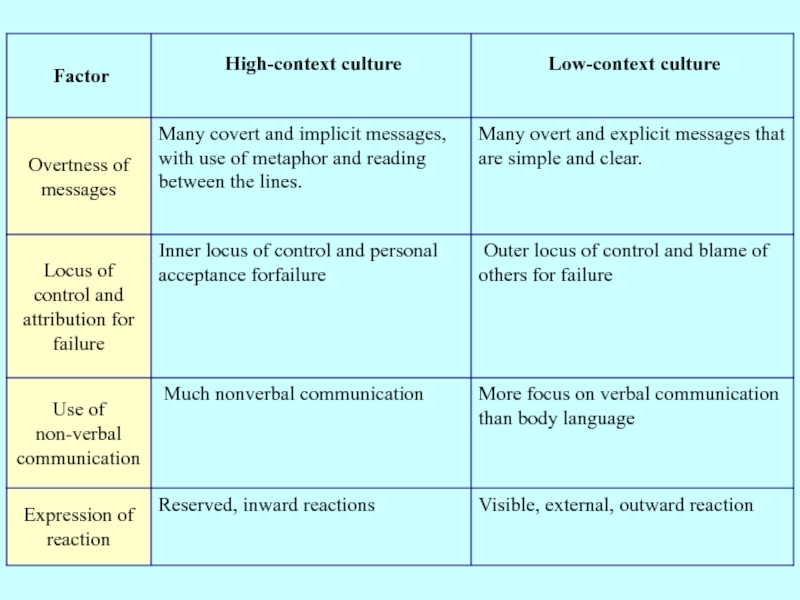
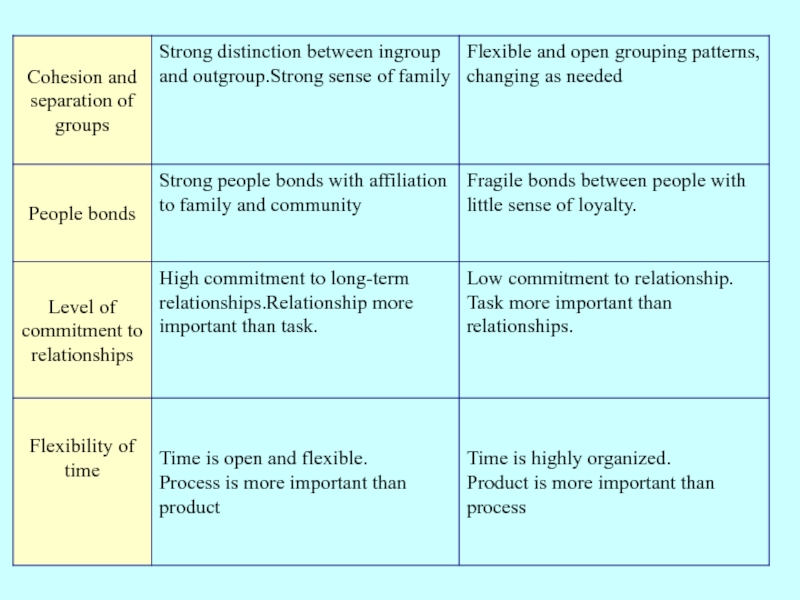


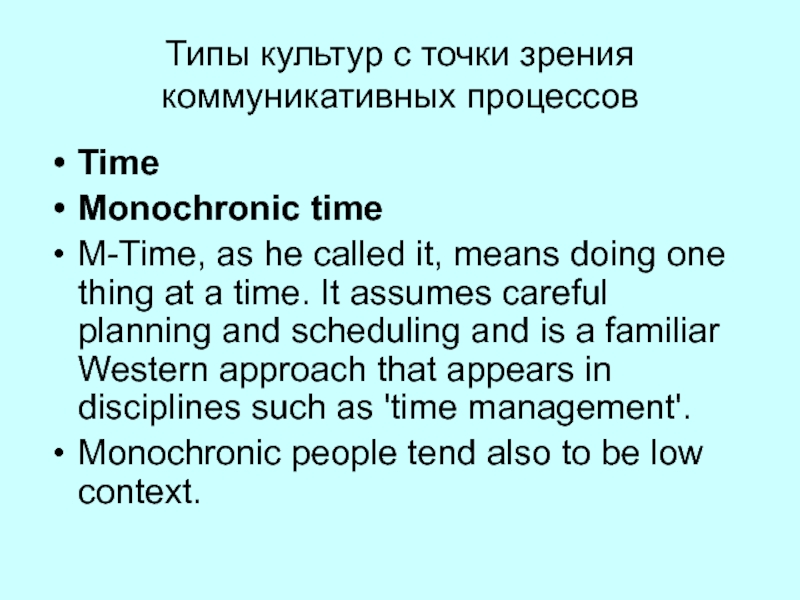
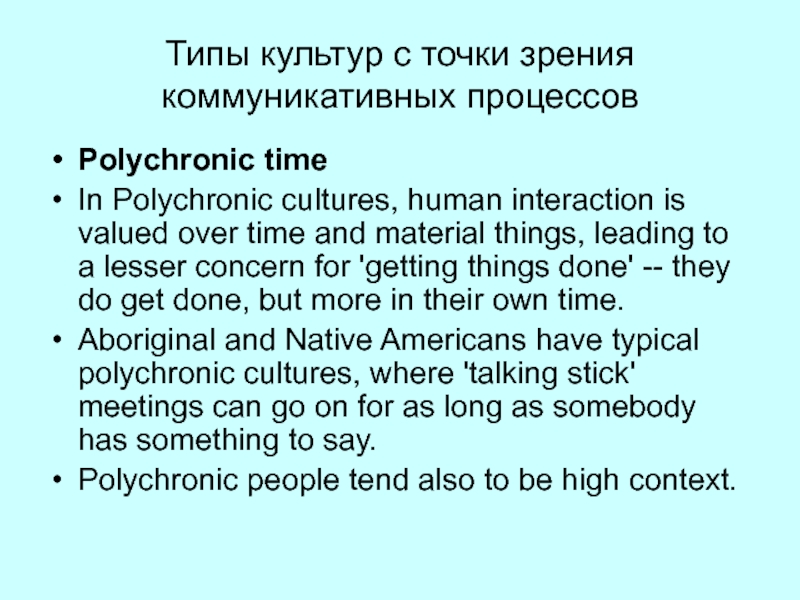
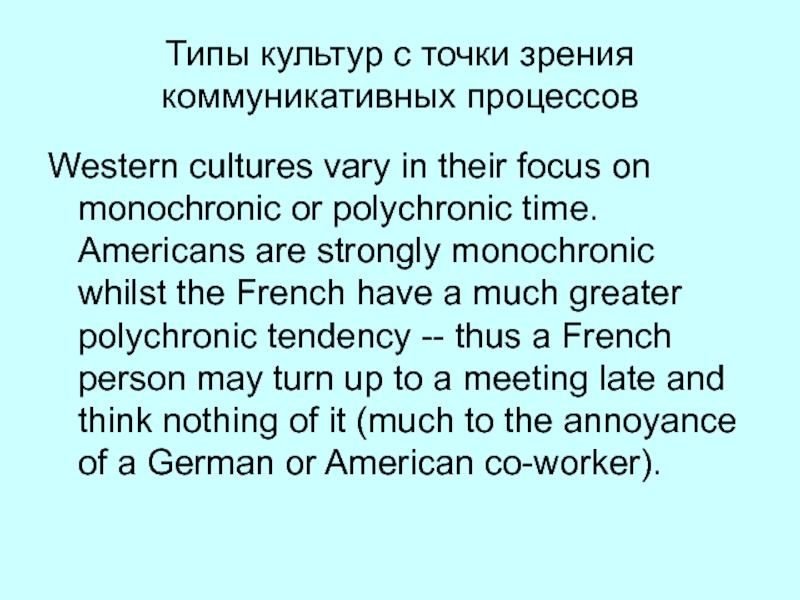
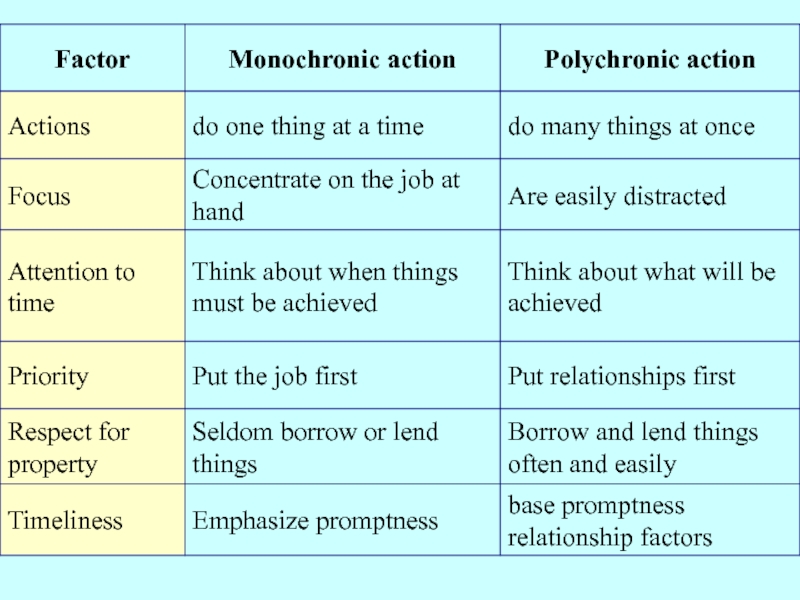
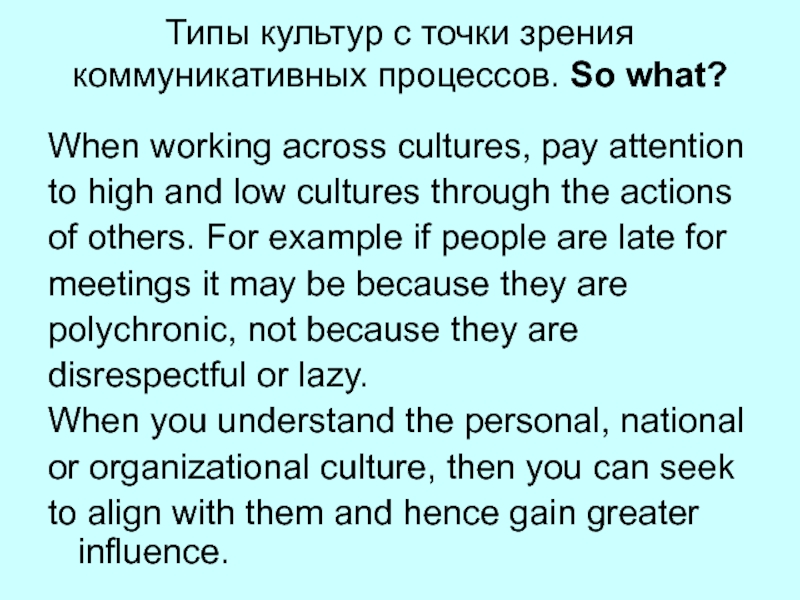
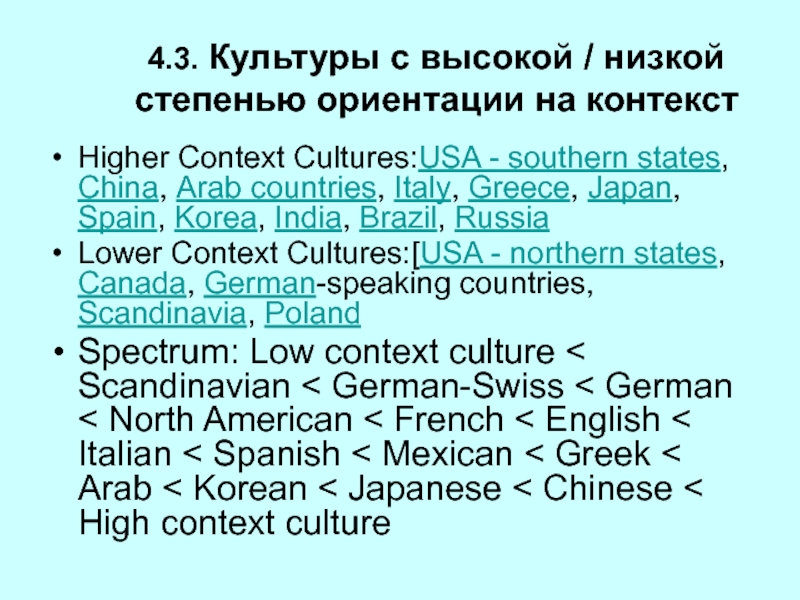
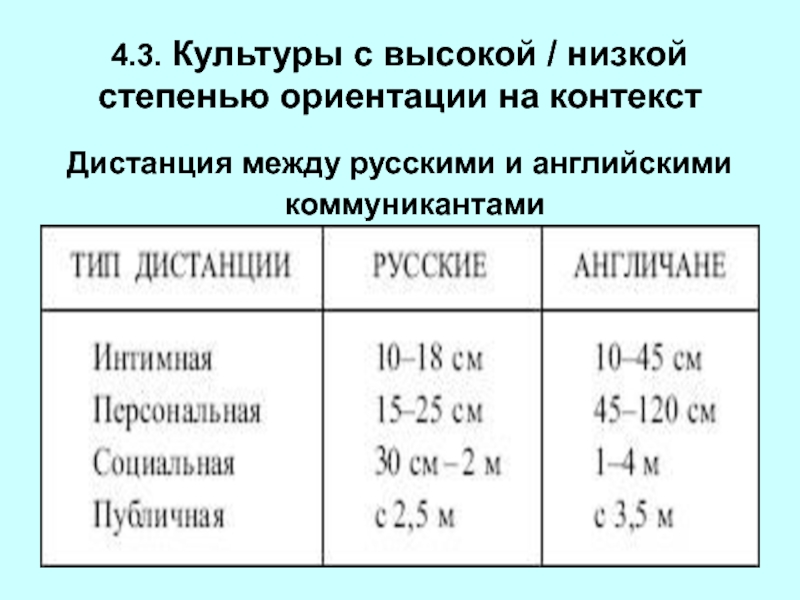
![Тема 4. Смысл и контекст 4.3. Культуры с высокой / низкой степенью ориентации на контекстprivacy [‘praıvəsı, 4.3. Культуры с высокой / низкой степенью ориентации на контекстprivacy [‘praıvəsı, ‘prıvəsı] 1) a state in which](/img/thumbs/a4e10052c9f1002b001a10995038698e-800x.jpg)
























